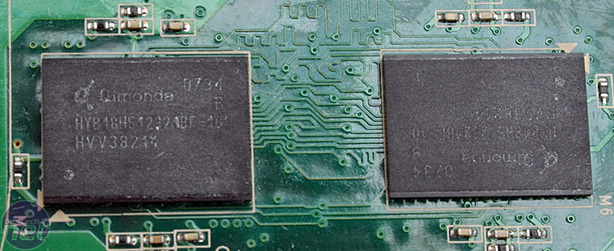Graphics DDR (GDDR)
If you purchased a PC within the last three years it will likely have at least one PCI Express graphical extension interface. These graphics cards have a specialised type of DDR, or Graphics DDR (GDDR) memory, ranging from a minimal few dozen Megabytes to in excess of a Gigabyte or more.GDDR is commonly used in high performance graphics cards with an extreme bandwidth requirement. It is structurally distinctive from DDR and should not be misconstrued as identical and in this respect GDDR does not belong in the same specification as JEDEC’s DDR standard.
The latest GDDR technology has evolved to the fifth generation, conveniently denoted as GDDR5. The main distinctions between different generations are performance and bandwidth. When compared to DDR, GDDR has higher performance ratings but is significantly more expensive in terms of manufacturing cost and power consumption.
GDDR3 operates at 2.0v as opposed to DDR3’s 1.5v, with the additional voltage helping GDDR to perform faster but making it have a tendency to leak more current, so it radiates more heat in the process. This combined with a large graphics core means graphics cards often generates more heat than the CPU and memory in a motherboard, combined.

Qimonda GDDR3 on the Nvidia 8800GT
GDDR has a relatively wider data interface and larger frame buffers. GDDR devices such as graphics cards have lower capacity per unit when compared against DDR counterparts; this is the cost of having higher power consumption and being more expensive. Raising GDDR memory capacity on a device will proportionally increase the power consumption and device price factor.
QDR and XDR
Quad-Data Rate (QDR) memory systems began as a co-development effort in 1999 by Cypress Semiconductor, IDT and NEC. Since then companies including Micron Technology, Renesas, Samsung Electronics and Hitachi have since participated in some form.We do not expect to see many, if any, discussions about Quad-Data Rate (QDR) memory replacing DDR because of the most important factors – low cost per bit cannot be fulfilled. Secondly, the move is tantamount to a major paradigm shift in memory technology which many manufacturers are very much against it. Everything comes down to economics and practicality.
While QDR’s data frequency and Valid Data Window are significantly higher, coupled with ultra low latency, it has a relatively low memory capacity relative to DDR. QDR3 memory capacity standard is measured in MB when DDR3 is reaching 8GB per module. QDR architecture was designed specifically for high-performance communication applications.
According to Lattice Semiconductor, the disadvantages of DDR technology when compared to QDR are:
- Writes and reads share one bidirectional data bus, therefore total bandwidth is halved as compared to the QDR architecture. This is significant in situations where the ratio of writes to reads is close to 1:1.
- Interruptions in data transfer are necessary for refresh.
- Access latency is relatively high.
- Requires initialization after power-up, and activation/precharge of rows before/after accesses (Memory Interface simplifies this).
There is a rare type of DDR2 called DDR2+ (or Enhanced DDR2) which is capable of operating at a core frequency of 333MHz juxtaposition to DDR2 standard 200MHz. DDR2+ was also jointly developed by the QDR consortium.
Next time we’ll look at mobile DDR and underlying DDR technologies like Temperature Compensated Self-Refresh, Partial Array Self-Refresh, Deep Power Down and Clock Stop Mode as well as DRAM packing and stacking techniques.

MSI MPG Velox 100R Chassis Review
October 14 2021 | 15:04









Want to comment? Please log in.